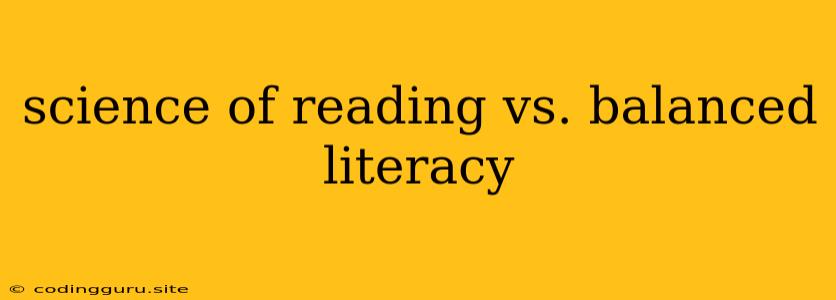Navigating the Debate: Science of Reading vs. Balanced Literacy
The world of early literacy instruction is buzzing with a debate: Science of Reading vs. Balanced Literacy. Both approaches aim to equip children with the skills to become fluent readers, but their methods and emphasis differ significantly. This article will delve into the core principles of each approach, explore the ongoing debate, and offer insights for parents and educators seeking to navigate this complex landscape.
What is the Science of Reading?
The Science of Reading is a research-based approach to literacy instruction that emphasizes the importance of explicit and systematic teaching of foundational reading skills. It's grounded in the understanding that reading is a complex cognitive process that involves decoding (sounding out words) and comprehension. This approach relies on a wealth of scientific evidence about how the brain learns to read.
Key principles of the Science of Reading:
- Phonemic Awareness: Understanding that spoken language is made up of individual sounds (phonemes) and the ability to manipulate these sounds.
- Phonics: The relationship between letters and sounds. Teaching children the sounds that letters represent and how to blend them together to read words.
- Fluency: The ability to read accurately, quickly, and with expression. Fluency is built through repeated reading and practice.
- Vocabulary: Knowing the meaning of words.
- Comprehension: Understanding the meaning of what is read.
What is Balanced Literacy?
Balanced Literacy is a broader approach that incorporates a variety of literacy practices, including both explicit and implicit instruction. It values a balance between skills-based instruction (phonics) and a focus on comprehension and enjoyment of reading.
Key principles of Balanced Literacy:
- Reading Workshop: A structured time for students to engage in independent reading, guided reading, and shared reading.
- Writing Workshop: A similar structure for writing where students practice various writing forms and styles.
- Word Work: Activities that focus on vocabulary, spelling, and word study.
- Literature Circles: Small groups of students who discuss and analyze a shared book.
The Science of Reading vs. Balanced Literacy Debate
The debate between these two approaches centers on the balance between explicit phonics instruction and a more holistic approach that incorporates reading for pleasure, writing, and discussion.
Proponents of the Science of Reading:
- Emphasis on Foundational Skills: They argue that explicit phonics instruction is essential for children to develop the foundational skills they need to become successful readers.
- Research-Based: They highlight the large body of research supporting the effectiveness of systematic phonics instruction.
- Focus on Struggling Readers: They argue that the Science of Reading approach is particularly beneficial for children who struggle to learn to read.
Proponents of Balanced Literacy:
- Holistic Approach: They believe that a balanced approach that incorporates a variety of literacy practices is more engaging and enjoyable for students.
- Importance of Motivation: They emphasize the role of reading for pleasure in fostering a love of reading.
- Flexibility: They argue that Balanced Literacy allows teachers to adapt their instruction to meet the needs of individual students.
Navigating the Debate: Finding the Right Path for Your Child
The Science of Reading vs. Balanced Literacy debate can be confusing for parents and educators.
Tips for Navigating the Debate:
- Understand the Research: Familiarize yourself with the research supporting both approaches.
- Talk to Your Child's Teacher: Discuss your concerns and ask about the approach used in your child's classroom.
- Observe Your Child's Learning: Pay attention to how your child is progressing and adjust your approach accordingly.
- Prioritize Early Intervention: If you notice your child is struggling, seek professional help from an educational specialist or reading tutor.
Ultimately, the best approach for your child will depend on their individual needs and learning style. It's important to find a balance between explicit phonics instruction and a broader approach that fosters a love of reading.
Key Considerations:
- Age: The needs of younger children differ from older students. Younger children often require more explicit phonics instruction, while older students may benefit from more independent reading and writing.
- Learning Style: Some children learn best through direct instruction, while others learn better through hands-on activities or through reading for pleasure.
- Reading Level: Children who struggle with reading often benefit from more explicit phonics instruction, while children who are already strong readers can benefit from a more balanced approach.
Example Scenarios:
- Scenario 1: A child is struggling to decode words in first grade. In this case, a more explicit phonics-based approach might be helpful to build their foundational skills.
- Scenario 2: A child in fourth grade is an avid reader but struggles with writing. A Balanced Literacy approach that incorporates writing workshops and guided writing practice could be beneficial.
Conclusion
The Science of Reading vs. Balanced Literacy debate is a complex one. Both approaches have their merits, and there is no one-size-fits-all solution. Ultimately, the best approach for your child will depend on their individual needs and learning style. It's important to be informed about the different approaches, communicate with your child's teacher, and observe your child's progress to ensure they are getting the best possible support.
